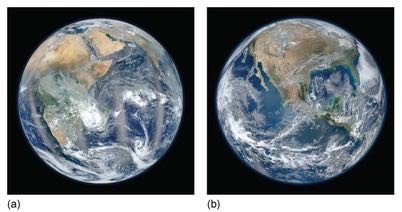3.2 Earth’s albedo
Figure 4 shows the Earth from space in two photos known as ‘Blue Marble 2012’. They show that the brightness of Earth’s surface is very varied.
Albedo (from the Latin for ‘white’) is the fraction of the solar radiation that hits the Earth (we call this the “incident” radiation) that is reflected.
Albedo is denoted by alpha α, with no units, because it is a fraction, the higher the value, the greater amount of solar radiation that is reflected. Surfaces that reflect more radiation tend to appear light (white or silver) and those that reflect less tend to appear dark. Different surfaces on the Earth have different values of albedo, as do different types and depths of cloud and particles in the atmosphere, such as dust or the sulfate aerosols you studied in Session 3.

Activity 3
Arrange these surfaces into order of decreasing albedo:
Two lists follow, match one item from the first with one item from the second. Each item can only be matched once. There are 5 items in each list.
-
1. (highest albedo)
-
2.
-
3.
-
4.
-
5.
Match each of the previous list items with an item from the following list:
a.thick cloud
b.agricultural crops
c.coniferous forest
d.sea ice
e.fresh snow
- 1 = e,
- 2 = a,
- 3 = d,
- 4 = b,
- 5 = c
Answer
The correct answer, with typical albedo ranges (α), is:
- fresh snow (0.75–0.95)
- thick cloud (0.7–0.9)
- sea ice (0.2–0.3)
- agricultural crops (0.16–0.26)
- coniferous forest (0.05–0.15)
(Sea ice values are from IPCC (2013), cloud values are from Schneider et al. (2011), and other values are from Campbell and Norman (1998)).
Earth has an average albedo of 0.30 so it reflects around 30% of the incoming energy from the Sun. As an Energy Balance Consultant, how might you increase this number?
